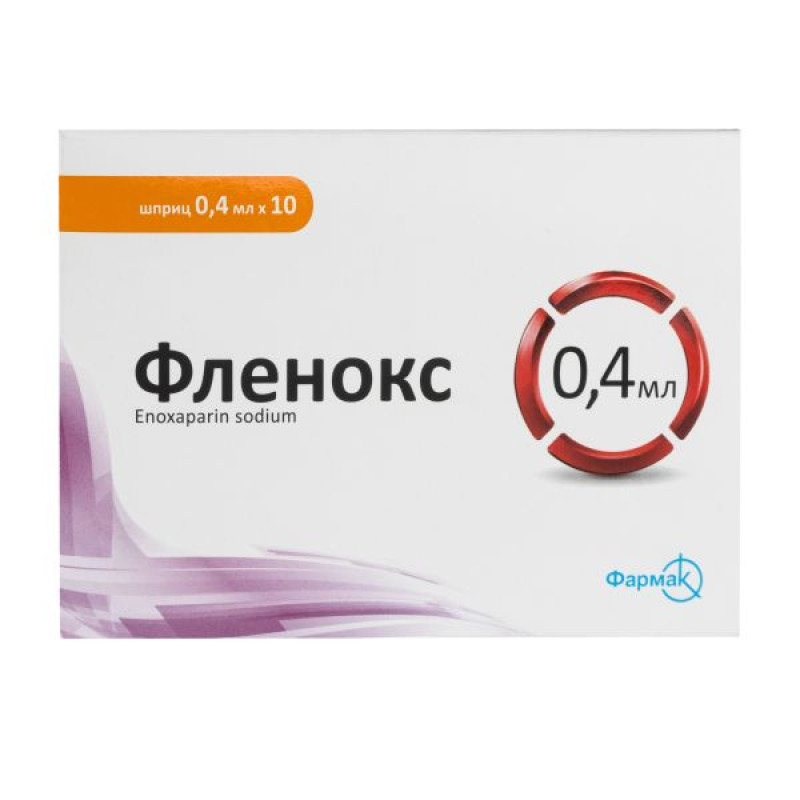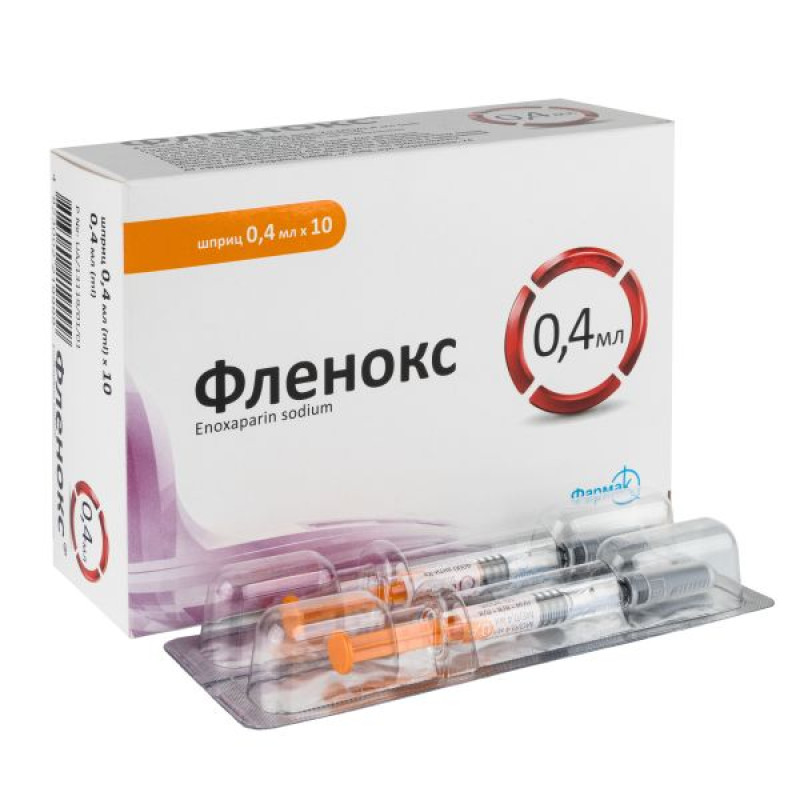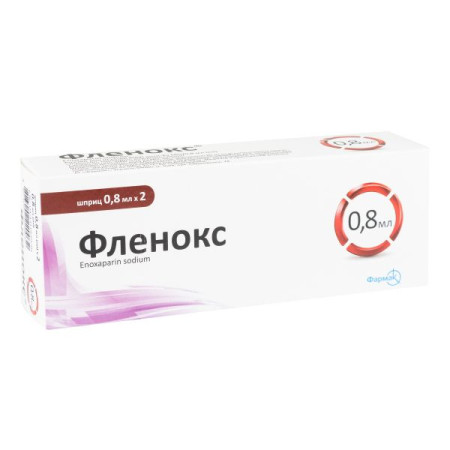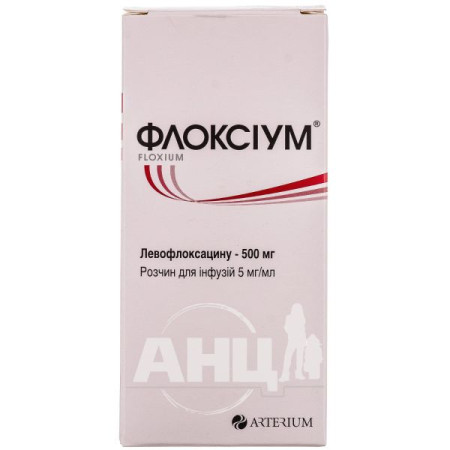Flenox injection solution 4000 anti-Xa IU syringe 0.4 ml No. 10
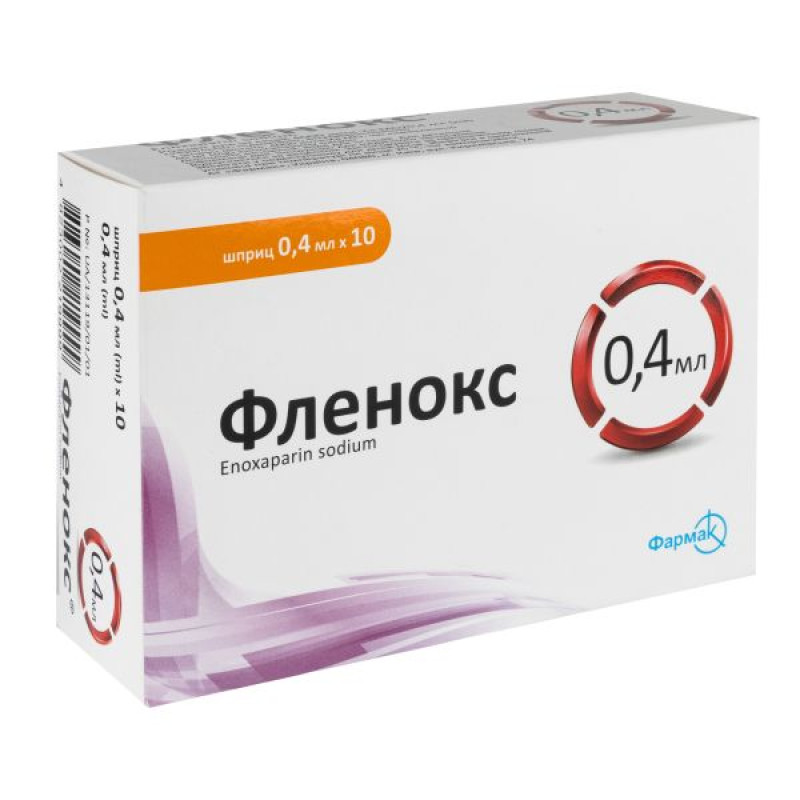
Instructions for use: Flenox injection solution 4000 anti-Xa IU syringe 0.4 ml No. 10
Composition
active ingredient: enoxaparin sodium;
1 ml of solution contains: 10,000 anti-Xa IU, equivalent to 100 mg of enoxaparin sodium;
2000 anti-Xa IU/0.2 ml, equivalent to enoxaparin sodium 20 mg;
4000 anti-Xa IU/0.4 ml, equivalent to enoxaparin sodium 40 mg;
6000 anti-Xa IU/0.6 ml, equivalent to enoxaparin sodium 60 mg;
8000 anti-Xa IU/0.8 ml, equivalent to enoxaparin sodium 80 mg;
excipient: water for injections.
Dosage form
Solution for injection.
Main physicochemical properties: transparent colorless or light yellow liquid.
Pharmacotherapeutic group
Antithrombotic agents. Heparin group. Enoxaparin.
ATX code B01A B05.
Pharmacological properties
Pharmacodynamics
Enoxaparin is a low molecular weight heparin (LMWH) that shares the antithrombotic and anticoagulant activities of standard heparin. It has higher anti-Xa activity than anti-IIa and antithrombin activity (the ratio for enoxaparin is 3.6).
When used in prophylactic doses, enoxaparin has no significant effect on aPTT (activated partial thromboplastin time).
When using therapeutic doses of the drug, the aPTT may be prolonged and exceed the control time of maximum activity by 1.5–2.2 times. This prolongation reflects residual antithrombin activity.
Treatment of acute ST-segment elevation myocardial infarction in combination with a thrombolytic agent in patients undergoing subsequent coronary angioplasty, as well as in patients who do not undergo this procedure.
In a large multicenter clinical trial, 20,479 patients with acute ST-segment elevation myocardial infarction after receiving fibrinolytic therapy were randomized to receive either enoxaparin as a bolus intravenous injection of 3000 anti-Xa IU, followed immediately by a subcutaneous dose of 100 anti-Xa IU/kg, followed by subcutaneous injections of 100 anti-Xa IU/kg every 12 hours, or intravenous unfractionated heparin as a bolus injection of 60 IU/kg (maximum 4000 IU/kg) followed by a continuous infusion at a dose adjusted according to the activated partial thromboplastin time. Subcutaneous injections of enoxaparin were administered until discharge from the hospital or for no more than 8 days (in 75% of cases – for no less than 6 days). Half of the patients receiving heparin received the drug for at least 48 hours (in 89.5% of cases ≥ 36 hours). All patients also received acetylsalicylic acid for at least 30 days. The dose of enoxaparin for patients aged ≥75 years was adjusted: 0.75 mg/kg (75 anti-Xa IU/kg) as a subcutaneous injection every 12 hours without an initial bolus intravenous injection.
In the study, 4716 (23%) patients underwent coronary angioplasty while receiving antithrombotic therapy with a masked study drug. Patients received no additional doses if less than 8 hours had passed since the last subcutaneous injection of enoxaparin before balloon inflation, or received a bolus intravenous injection of enoxaparin at a dose of 0.3 mg/kg (30 anti-Xa IU/kg) if more than 8 hours had passed since the last subcutaneous injection of enoxaparin before balloon inflation.
Enoxaparin significantly reduced the incidence of events corresponding to the primary endpoints (a composite endpoint including recurrent myocardial infarction and all-cause mortality occurring during the 30-day follow-up period after inclusion in the study: 9.9% in the enoxaparin group compared with 12% in the unfractionated heparin group (relative risk reduction of 17% (p<0.001)). The incidence of recurrent myocardial infarction was significantly lower in the enoxaparin group (3.4% compared with 5%, p<0.001, relative risk reduction of 31%). Mortality was lower in the enoxaparin group, but the difference between the groups was not statistically significant (6.9% compared with 7.5%, p=0.11).
The advantage of enoxaparin in terms of the primary endpoint was unconditional regardless of subgroup (age, sex, location of myocardial infarction, diabetes or history of myocardial infarction, type of thrombolytic prescribed, and time interval between the appearance of the first clinical signs and the start of treatment).
Enoxaparin demonstrated a significant advantage over unfractionated heparin on the primary efficacy endpoint in both patients who underwent coronary angioplasty within 30 days of study entry (10.8% vs. 13.9%, 23% relative risk reduction) and patients who did not undergo coronary angioplasty (9.7% vs. 11.4%, 15% relative risk reduction).
Analysis of the combined criteria used to determine clinical benefit showed a statistically significant advantage (p<0.0001) of enoxaparin over unfractionated heparin: a relative risk reduction of 14% in favor of enoxaparin (11% versus 12.8%) for the combined criteria of death, recurrent myocardial infarction, and major bleeding (TIMI criteria) up to day 30, and 17% (10.1% versus 12.2%) for the combined criteria of death, recurrent myocardial infarction, and intracranial hemorrhage up to day 30.
Pharmacokinetics
The pharmacokinetic parameters of the drug are assessed by changes in anti-Xa and anti-IIa activity in blood plasma over time in the recommended dose ranges.
Bioavailability: Enoxaparin is rapidly and almost completely (almost 100%) absorbed after subcutaneous administration. Peak plasma activity is observed between 3 and 4 hours after administration.
This maximum activity (expressed in anti-Xa IU) is 0.18±0.04 (after administration of 2000 anti-Xa IU), 0.43±0.11 (after administration of 4000 anti-Xa IU) and 1.01±0.14 (after administration of 10000 anti-Xa IU).
A bolus intravenous injection of 30 mg (0.3 ml; 3000 anti-Xa IU) followed by subcutaneous injections of 1 mg/kg (100 anti-Xa IU/kg) every 12 hours results in a first maximum anti-factor Xa concentration of 1.16 IU/ml (n=16) and a mean AUC corresponding to 88% of steady state. Steady state is reached on the second day of treatment.
The pharmacokinetics of enoxaparin are linear over the recommended dose range. Intra- and inter-patient variability is minimal. After repeated subcutaneous administration of 40 mg (0.4 ml; 4000 anti-Xa IU) once daily to healthy volunteers, steady state was achieved by day 2, with mean enoxaparin activity approximately 15% higher than that observed after a single dose. Steady-state levels of enoxaparin activity are reasonably predictable after single doses. After repeated subcutaneous administration of 1 mg/kg (100 anti-Xa IU/kg) twice daily, steady state was reached between days 3 and 4, with mean AUC being 65% higher than that observed with a single dose, and maximum and minimum anti-Xa activities being 1.2 and 0.52 anti-Xa IU/ml, respectively. Based on the pharmacokinetics of enoxaparin sodium, this difference in steady state would be expected also for the therapeutic dose range.
Anti-Xa activity in plasma after subcutaneous administration is almost 10 times lower than anti-IIa activity. The mean maximum anti-Xa activity is observed approximately 3–4 hours after subcutaneous injection, reaching 0.13 anti-Xa IU/ml after repeated administration of a dose of 1 mg/kg (100 anti-Xa IU/kg) twice daily.
Distribution: The volume of distribution of enoxaparin sodium for anti-Xa activity is approximately 5 liters and almost corresponds to the volume of circulating blood.
Metabolism: Enoxaparin is metabolized primarily in the liver (by desulfation and depolymerization).
Elimination: After subcutaneous injection, the half-life of anti-Xa activity for low molecular weight heparins is longer than that for unfractionated heparins.
The elimination of enoxaparin is monophasic, with a half-life of approximately 4 hours after a single subcutaneous injection and almost 7 hours after repeated doses. Low molecular weight heparins are characterized by a more rapid decline in anti-IIa activity in plasma compared with anti-Xa activity.
Enoxaparin and its metabolites are excreted in the urine (unsaturable mechanism) and also in the bile.
Renal clearance of substances with anti-Xa activity is 10% of the administered dose, and total renal excretion of active and inactive metabolites is 40% of the dose.
High-risk groups
Elderly patients. Since this age group has a physiological decline in renal function, elimination is slower. This does not affect the dosage or administration regimen for prophylactic treatment. In patients over 75 years of age, it is very important to systematically monitor renal function using the Cockcroft formula before starting treatment with LMWH.
Patients with mild to moderate renal impairment (creatinine clearance >30 ml/min). In some cases, it may be useful to monitor anti-Xa activity to rule out the possibility of overdose if enoxaparin is used in therapeutic doses.
Indication
– Prevention of venous thromboembolism during surgical interventions accompanied by moderate and high thrombogenic risk;
– prevention of deep vein thrombosis in patients who are on bed rest due to acute therapeutic diseases: heart failure class III or IV according to the NYHA classification, acute respiratory failure, acute infectious or rheumatic disease, in the presence of at least one other risk factor for venous thromboembolism;
– treatment of diagnosed deep vein thrombosis, with or without pulmonary embolism and without severe clinical symptoms, with the exception of pulmonary embolism requiring treatment with a thrombolytic agent or surgery;
– treatment of unstable angina and acute non-Q-wave myocardial infarction in combination with acetylsalicylic acid;
– treatment of acute myocardial infarction with ST-segment elevation in combination with a thrombolytic agent in patients who may undergo further coronary angioplasty, as well as in patients who are not candidates for this procedure.
Contraindication
For doses of 2000 anti-Xa IU/0.2 ml, equivalent to 20 mg enoxaparin sodium;
4000 anti-Xa IU/0.4 ml, equivalent to enoxaparin sodium 40 mg;
6000 anti-Xa IU/0.6 ml, equivalent to enoxaparin sodium 60 mg;
8000 anti-Xa IU/0.8 ml, equivalent to enoxaparin sodium 80 mg;
This medicine is generally not recommended in the following cases:
Hypersensitivity to enoxaparin, heparin or its derivatives, including other low molecular weight heparins.
History of severe heparin-induced thrombocytopenia (HIT) type II caused by unfractionated heparin or low molecular weight heparin (see section "Special warnings and precautions for use").
Bleeding or bleeding tendency associated with impaired hemostasis (a possible exception to this contraindication may be disseminated intravascular coagulation, if it is not associated with heparin therapy (see section "Special instructions").
Organic lesions that can cause bleeding.
Active clinically significant bleeding.
In addition, this drug is generally not recommended for use in prophylactic doses in patients aged 65 years and older in combination with the following drugs (see section “Interaction with other drugs and other types of interactions”):
Acetylsalicylic acid in analgesic, antipyretic and anti-inflammatory doses.
Nonsteroidal anti-inflammatory drugs (NSAIDs) (systemic use).
Dextran40 (parenteral use).
For doses of 2000 anti-Xa IU/0.2 ml, equivalent to 20 mg enoxaparin sodium;
4000 anti-Xa IU/0.4 ml, equivalent to enoxaparin sodium 40 mg;
This medicine is usually not recommended for use:
- patients with severe renal insufficiency (creatinine clearance, calculated according to the Cockcroft formula, 30 ml/min, see section "Special instructions for use");
- within the first 24 hours after intracerebral hemorrhage.
For doses of 6000 anti-Xa IU/0.6 ml, equivalent to 60 mg enoxaparin sodium;
8000 anti-Xa IU/0.8 ml, equivalent to enoxaparin sodium 80 mg;
This medicine is generally not recommended in the following cases:
Intracerebral hemorrhage.
Active stomach or duodenal ulcer.
Due to the lack of relevant data, the drug is not used in patients with severe renal insufficiency (creatinine clearance calculated according to the Cockcroft formula, 30 ml/min), with the exception of patients on dialysis. Patients with severe renal insufficiency should be prescribed unfractionated heparin. To calculate according to the Cockcroft formula, it is necessary to have the data of the last measurement of the patient's body weight (see section "Peculiarities of use").
Spinal or epidural anesthesia should never be used in patients who are being treated with low molecular weight heparins (LMWHs).
Local anesthesia for elective surgery is contraindicated in patients receiving heparin for treatment rather than prophylaxis.
It is not recommended to use this drug in such cases.
In acute massive ischemic stroke with or without loss of consciousness. If the stroke is caused by embolism, enoxaparin should not be used in the first 72 hours after the stroke.
The effectiveness of therapeutic doses of LMWH has not been determined to date, regardless of the cause, extent of the lesion, or severity of clinical manifestations of cerebral infarction.
In acute infective endocarditis (except for some heart diseases caused by embolism).
In mild or moderate renal failure (creatinine clearance 30–60 ml/min).
Interaction with other medicinal products and other types of interactions
Certain drugs or therapeutic classes of drugs may contribute to the development of hyperkalemia: potassium salts, potassium-sparing diuretics, angiotensin-converting enzyme inhibitors, angiotensin II receptor inhibitors, NSAIDs, heparins (low molecular weight or unfractionated), cyclosporine, tacrolimus, and trimethoprim.
The development of hyperkalemia may depend on whether the patient has associated risk factors. The risk of hyperkalemia is increased if the above-mentioned drugs are used concomitantly.
Elderly patients (65 years and older).
Undesirable combinations
With NSAIDs, including ketorolac (systemic administration). Increased risk of bleeding (suppression of platelet function and damage to the gastrointestinal mucosa by NSAIDs). If concomitant use cannot be avoided, careful clinical monitoring should be performed.
With dextran 40 (parenteral administration). Increased risk of bleeding (suppression of platelet function by dextran 40).
With other thrombolytics (e.g. alteplase, reteplase, streptokinase, tenecteplase, urokinase) and anticoagulants.
Combinations requiring precautions.
With oral anticoagulants. Increased anticoagulant effect. Clinical monitoring should be increased when replacing heparin with an oral anticoagulant.
Combinations to consider.
With platelet aggregation inhibitors (except acetylsalicylic acid in analgesic, antipyretic and anti-inflammatory doses), such as abciximab, acetylsalicylic acid in antiplatelet doses for cardiological and neurological indications, beraprost, clopidogrel, eptifibatide, iloprost, ticlopidine, tirofiban: increased risk of bleeding.
Enoxaparin sodium should be used with caution with systemic corticosteroids.
Patients under 65 years of age.
Combinations to be considered. The combined use of drugs that affect hemostasis may increase the risk of bleeding. Therefore, regardless of the age of patients, consideration should be given (and therefore long-term clinical monitoring and possibly laboratory testing) to the effects of concomitant use of LMWH in prophylactic doses with the following drugs: oral anticoagulants, platelet aggregation inhibitors (abciximab, NSAIDs, acetylsalicylic acid at any dose, clopidogrel, eptifibatide, iloprost, ticlopidine, tirofiban) and thrombolytic drugs.
Application features
The drug is not allowed to be administered intramuscularly.
Although the concentrations of various LMWHs are expressed in international units (IU) of anti-Xa activity, their efficacy does not depend solely on their anti-Xa activity. It is dangerous to substitute one LMWH dosage regimen for another or for another synthetic polysaccharide, since each regimen has been supported by specific clinical studies. Therefore, special caution and specific instructions for use should be observed when using each drug.
Precautions during use.
Risk of bleeding. The recommended dosage regimens (doses and duration of treatment) must be followed. Failure to follow these recommendations may lead to bleeding, particularly in patients at increased risk (elderly patients, patients with renal insufficiency).
Cases of severe bleeding have been reported in elderly patients, in particular due to age-related decline in renal function; in patients with renal insufficiency; in patients weighing less than 40 kg; in treatment lasting longer than the recommended average duration of 10 days; in non-compliance with therapeutic recommendations (in particular those concerning the duration of treatment and dose adjustment according to body weight during treatment); in concomitant use with drugs that increase the risk of bleeding (see section "Interaction with other medicinal products and other types of interactions").
In any case, elderly patients and/or patients with renal insufficiency, as well as patients whose treatment lasts more than 10 days, should be under special supervision.
In some cases, quantitative determination of anti-Xa activity may be useful to detect drug accumulation (see section "Special instructions").
Risk of HIT. The possibility of developing HIT should always be assumed and platelet levels should be urgently determined (see section "Special instructions for use") if the following thrombotic complications develop in a patient receiving LMWH (in therapeutic or prophylactic doses):
- exacerbation of thrombosis, the treatment of which is being carried out;
- phlebitis;
- pulmonary embolism;
- acute ischemia of the lower extremities;
- myocardial infarction or ischemic stroke.
Mechanical heart valve prostheses.
The use of enoxaparin for the prevention of thromboembolic complications in patients with mechanical prosthetic heart valves has not been studied separately. However, a few isolated cases of thrombosis have been reported in patients with mechanical prosthetic heart valves who received enoxaparin for the prevention of thromboembolic complications.
Pregnancy. In a clinical study involving pregnant women with mechanical heart valve prostheses who received enoxaparin at a dose of 100 anti-Xa IU enoxaparin/kg twice daily to reduce the risk of thromboembolic complications, two of eight pregnant women developed thrombosis resulting in valve obstruction, resulting in maternal and fetal death. Isolated cases of mechanical heart valve thrombosis in pregnant women receiving enoxaparin for the prevention of thromboembolic complications have also been reported during post-marketing surveillance of the drug. Therefore, these patients are at increased risk of thromboembolic complications.
Medical prevention.
Prophylactic treatment is justified in the case of acute infection or rheumatic disease only if at least one of the following risk factors for venous thromboembolism is present:
- cancer disease;
- history of venous thromboembolism;
- obesity;
- hormone treatment;
- heart failure;
- chronic respiratory failure.
There is very limited experience with prophylactic use in patients aged 80 years and older and weighing less than 40 kg.
Precautions when using.
Bleeding: As with other anticoagulants, bleeding may occur (see section 4.8). If bleeding occurs, the cause should be investigated and appropriate treatment should be initiated.
Renal function: Before starting LMWH treatment, renal function should be assessed, particularly in patients aged 75 years and over, by determining creatinine clearance (CC) according to the Cockcroft formula, using the latest body weight measurement:
- for male patients: CC = (140–age) × body weight/(0.814 × serum creatinine), where age is expressed in years, body weight in kilograms, and serum creatinine in μmol/L;
- for women, this formula is adjusted by multiplying the result by 0.85.
If serum creatinine is expressed in mg/ml, the value should be multiplied by a factor of 8.8.
The use of LMWH in therapeutic doses is contraindicated in patients with diagnosed severe renal insufficiency (creatinine clearance of approximately 30 ml/min) (see section "Contraindications").
Obese patients. Obese patients are at increased risk of thromboembolism. The safety and efficacy of prophylactic doses in obese patients (body mass index > 30 kg/m2) have not been fully established and no dose adjustment recommendations are available for these patients. These patients should be closely monitored for signs and symptoms of thromboembolism.
Laboratory indicators.
Monitoring platelet levels in patients using LMWH and at risk of HIT (e.g., type II HIT).
LMWH may cause the development of type II HIT, a serious immune-mediated thrombocytopenia that can lead to arterial or venous thromboembolic events that can be life-threatening or worsen the functional prognosis of patients (see section 4.8). Appropriate surveillance of patients is necessary for the timely detection of HIT.
Patients who have undergone surgery or have recently suffered a trauma (within 3 months). Regardless of whether the drug is prescribed for treatment or prophylaxis, all patients should have systematic laboratory tests, since the frequency of GIT is > 0.1% or even > 1% in surgery and traumatology. These tests should include platelet count:
- before prescribing LMWH or no later than 24 hours after starting therapy with the drug;
- then twice a week for one month (period of maximum risk);
- subsequently, in the case of long-term treatment - once a week until treatment is discontinued.
Patients with other conditions other than surgery or recent trauma (within 3 months). Regardless of whether the drug is prescribed for treatment or prophylaxis, systematic laboratory tests are necessary according to the same principles as those used in surgery and traumatology (see above) in patients:
- who have previously received unfractionated heparin (UFH) or LMWH in the last 6 months, given that the incidence of HIT is > 0.1% or even > 1%;
- who have significant comorbidities, given the potential severity of HIT in such patients.
In other cases, given the lower incidence of HIT (<0.1%), platelet count monitoring may be limited to the following measures:
- a single control of platelet count at the beginning of treatment or no later than 24 hours after the start of treatment;
- monitoring of platelet counts in the presence of clinical symptoms suggestive of HIT (any new episode of arterial and/or venous thromboembolism, any painful skin lesion at the injection site, any allergic or anaphylactic symptoms during treatment). Patients should be informed of the possibility of such symptoms and of the need to report them to their physician.
GIT should be suspected if the platelet count is below 150,000/mm3 (or 150 g/l) and/or if there is a relative decrease in platelet count of 30-50% compared to the platelet count before treatment. GIT develops mainly from the 5th to the 21st day after the start of heparin treatment (with a maximum incidence of development after about 10 days). However, in patients with a history of GIT, this complication may occur much earlier. Isolated cases have also been observed after the 21st day of treatment. In this regard, systematic efforts should be made to identify patients with such a history by detailed questioning before starting treatment. In all cases, the occurrence of GIT is an emergency and requires specialist consultation. Any significant decrease in platelet count (by 30-50% compared to the initial values) is a warning signal, even if the values have not reached a critical level. If a decrease in platelet count is observed, the following measures must be taken in all cases:
Discontinue heparin therapy if this test confirms a decrease in platelet count or even indicates an increase and if no other obvious cause is found. For in vitro platelet aggregation and immunological testing, the sample should be placed in a tube with citrate solution. However, in such circumstances, the immediate measures to be taken should not be based on the results of the in vitro platelet aggregation or immunological testing, since there are only a few specialized laboratories that can perform such tests routinely and the results can be obtained at best only after a few hours. However, such tests are necessary because they can help diagnose this complication, since the risk of thrombosis with continued heparin treatment in such cases is very high.
To prevent or treat thrombotic complications associated with HIT. If continued anticoagulant therapy is essential, heparin should be replaced by an antithrombotic agent from another class of drugs, such as danaparoid sodium or lepirudin, administered in therapeutic or prophylactic doses tailored to the individual patient. Replacement with oral anticoagulants should only be done after platelet counts have returned to normal, as there is a risk of exacerbation of thrombosis with oral anticoagulants.
Replacing heparin with oral anticoagulants.
Clinical surveillance should be intensified and laboratory tests (prothrombin time expressed as international normalized ratio (INR)) should be performed more frequently to monitor the efficacy of oral anticoagulants.
Due to the time lag for the maximum effect of oral anticoagulants to occur, heparin treatment at a constant dose should be continued for the time necessary to maintain the MNC within the desired therapeutic range as determined in two consecutive assays.
Monitoring of anti-factor Xa activity. Since most clinical studies that have demonstrated the efficacy of LMWH were conducted using a dose calculated according to the patient's body weight and without specific monitoring of laboratory parameters, the value of laboratory monitoring in assessing the efficacy of LMWH has not been established. However, monitoring of anti-factor Xa activity may be useful in monitoring the risk of bleeding in certain clinical situations that are often associated with the risk of overdose.
These situations mainly concern the therapeutic indications for the use of LMWH and are associated with the doses administered to patients with:
- mild to moderate renal insufficiency (CC - approximately 30-60 ml/min, calculated by the Cockcroft formula). Since LMWH is excreted mainly in the urine, unlike standard unfractionated heparin, any renal insufficiency may cause a relative overdose. Severe renal insufficiency is a contraindication to the use of LMWH in therapeutic doses (see section "Contraindications");
- excessively high or excessively low body weight (weight loss or even cachexia, obesity);
- bleeding of unknown etiology.
In contrast, monitoring of laboratory parameters is not recommended during prophylactic doses, if LMWH is used according to therapeutic recommendations (in particular regarding duration of treatment) or during hemodialysis.
To detect possible heparin accumulation after multiple administration of the drug, it is recommended, if necessary, to collect blood for analysis at the peak of activity (based on available data), i.e. approximately 4 hours after the third injection, if the drug is administered as subcutaneous injections 2 times a day.
The question of whether to repeat anti-Xa activity tests to determine heparin levels in the blood, for example every 2–3 days, should be decided on an individual basis, depending on the results of the previous test. The possibility of adjusting the dose of LMWH should also be considered.
It has been determined that anti-Xa activity varies depending on the type of each LMWH and each dosing regimen.
Based on available data, the mean (± standard deviation) value observed 4 hours after the seventh injection of enoxaparin at a dose of 100 anti-Xa IU/kg/injection twice daily was 1.20 ± 0.17 anti-Xa IU/mL.
This average value was observed in clinical studies in which the study of anti-Xa activity was carried out by the chromogenic (amidolytic) method.
Control of APTT.
Some LMWHs cause a modest increase in APTT. Since the clinical significance of this test has not been established, there is no need to use this test for monitoring treatment.
Spinal/epidural anesthesia in patients receiving prophylactic LMWH treatment. Epidural or spinal anesthesia should never be performed on patients receiving therapeutic doses of LMWH.
The risk of developing a spinal hematoma is higher with epidural anesthesia, which is performed using a catheter, than with spinal anesthesia.
The risk of these rare events may be increased with prolonged use of epidural catheters in the postoperative period or in patients who have had previous spinal surgery or spinal deformity (e.g. ankylosing spondylitis).
Catheter insertion or removal is best performed when the anticoagulant effect of enoxaparin is low. However, the exact time to achieve a sufficiently low anticoagulant effect in each individual patient is unknown.
If preoperative use of LMWH is necessary (patients who are bedridden for a long time, trauma) and if the benefit of local/regional spinal anesthesia or lumbar puncture has been carefully weighed, patients who have received a preoperative LMWH injection may be given such anesthesia, provided that at least 12 hours have elapsed between the heparin injection and spinal anesthesia. However, since anti-Xa activity may persist beyond this 12-hour interval, neuraxial hematoma may still occur. In patients with a creatinine clearance < 30 mL/min, it may be advisable to wait at least 24 hours between heparin injection and spinal anesthesia.
It is recommended to carefully monitor the patient's neurological status, keeping in mind the risk of spinal hematoma.
In almost all patients, LMWH prophylactic therapy can be initiated 6–8 hours after anesthesia or after catheter removal, with monitoring of neurological status.
Special caution should be exercised when using the drug simultaneously with other drugs that affect hemostasis (especially nonsteroidal anti-inflammatory drugs, aspirin).
Conditions that carry a special risk.
Monitoring of treatment should be increased in the following cases:
- liver failure;
- history of gastrointestinal ulcers or other organic lesions that may cause bleeding;
- vascular chorioretinal disease;
- postoperative period after surgical intervention on the brain or spinal cord;
- lumbar puncture: the risk of intraspinal bleeding should be taken into account and, if possible, its performance should be postponed as long as possible;
- simultaneous use with drugs that affect hemostasis (see section "Interaction with other medicinal products and other types of interactions").
Percutaneous coronary revascularization procedures.
To minimize the risk of bleeding in patients undergoing PCI for the treatment of unstable angina, non-Q-wave myocardial infarction, or acute ST-segment elevation myocardial infarction, the recommended time intervals between doses of enoxaparin should be strictly adhered to. It is important to achieve hemostasis at the puncture site after PCI. If special means for closing the vessel (hemostatic devices) are used, the guidewire should be removed immediately. In the case of manual compression, the guidewire should be removed 6 hours after the last subcutaneous/intravenous injection of enoxaparin. If treatment with enoxaparin is continued, the next injection should be given no earlier than 6–8 hours after guidewire removal. The skin puncture site during PCI should be observed for any signs of bleeding or hematoma.
Acute generalized exanthematous pustulosis
Acute generalized exanthematous pustulosis (AGEP) has been reported with an unknown frequency in association with enoxaparin treatment. Patients should be advised of the signs and symptoms and monitored closely for skin reactions when prescribed. If signs and symptoms suggestive of these reactions occur, enoxaparin should be discontinued immediately and alternative therapy considered.
There are no reviews for this product.
There are no reviews for this product, be the first to leave your review.
No questions about this product, be the first and ask your question.







